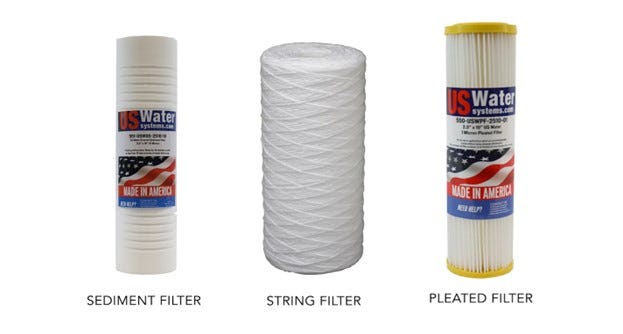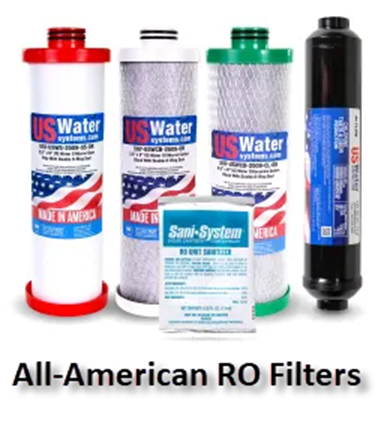When Should I Change My Filters?
How to know when to change your water filters and why you should.
Before we can discuss changing water filters. First, what is a water filter? Wikipedia defines water filter like this:
A water filter removes impurities by lowering contamination of water using a fine physical barrier, a chemical process, or a biological process.
Simply put, a water filter is a method used to filter out undesired chemical compounds, organic and inorganic materials, and biological contaminants.

There are tons of different water filters and the intervals for changing the filters vary depending upon several key factors:
- The Type of Filter;
- The Water Quality;
- The Level of Competing Contaminants; and
- The Amount of Water Used.
1. The Type of Filter
Maybe you have a whole house water filter for filtering sand, silt and sediment. How often you change that may depend upon how much of that is in your water. It also depends upon what micron level you need to filter the water. Is it 20 microns, 10 microns, 5 microns, 1 micron, or is it sub-micron? Depending on all the variables, you may have to change that filter daily or yearly.
OK, I realize that's not much help. Let's get a little more granular. Not only are there several types of filters, but within each type there are many varieties. For example, if you have a sediment filter which is generally used for a whole house, there are additional options to choose from. I am going to list them in order of effectiveness (from least effective to most effective):

- Sediment Depth Filter - A sediment depth filter is often made of spun polyethylene and is a gradient density filter. That simply means that on the outside, the filter may be 30 microns, but the deeper you go, the denser it becomes and may become 5 microns. This filter is excellent for point-of-use filters such as an under sink reverse osmosis system or drinking water filter. It is not, however, a good choice for whole house filtration application as it is too restrictive, holds too little dirt and does not have the longevity needed.
- String-Wound Filter - Many customers say that they love their string wound filters. When you ask them why, they will tell you something like well they last a very long time. Of course, they do - Because they don't trap much sediment! It just passes through. String filters were invented when dinosaurs roamed the earth. In my opinion, string wound filters should be extinct. If you are just content with having the longest intervals between filter changes, TAKE OUT THE FILTER from the housing and never worry about it! I am being sarcastic about this, of course, but I want you to understand the disdain I have for string filters.
- Pleated Polyester Filters - Both of the above-mentioned filters are depth filters. The pleated polyester filters are what are called surface filters. The filter is pleated to have the maximum surface area for filtration. Some of these filters are made of paper, not polyester which allows the bacteria in the water to literally dissolve some of the filter, thus rendering it useless. Some manufacturers cheapen their filters by putting in less media (fewer pleats) which means that they cost less and do not last as long. In the 4.5 x 20 series of whole house filters some manufacturers have as little as 16 to 20 sq/ft of media. Contrast that with the Magna Filter from US Water Systems which has 32 sq/ft of media (the most in the industry). It filters better and lasts longer.

- Carbon Filters - Carbon filters used to be Granular Activated Carbon Filters or GAC filters. While they are still popular, carbon block filters have supplanted the GAC types of filters because of longevity, performance, and the absence of messy black water upon start-up.
- Specialty Filters - There are filters for about any application you can imagine. This includes removal of nitrate, arsenic, iron, fluoride, chloramine, hardness, PFAS, bacteria, and many others. There are also filters that deionize the water and add things to it, such as calcite and polyphosphate.
So, as you can see, the filter type is key to how often you have to change your filters. If you had a softening cartridge, you literally might have to change it evert 20 minutes in order to get soft water. However, if you have a properly sized whole-house sediment filter, you may have to change it every six months to one year depending upon the other Three Key Factors.
2. The Water Quality
The quality of the water being filtered is also paramount. If you are filtering water that is cloudy, rusty, black or full of sediment, the challenge is much greater. If the water is full of iron, sulfur, manganese, sand, silt and/or sediment, then you may be fighting a losing battle. Before any cartridge filter, it may be necessary to oxidize the iron, sulfur, and /or manganese with an oxidation filter that may use chlorine, hydrogen peroxide or oxygen as an oxidizer to remove it from the water before any cartridge filtration.
This is especially true is any of the water contains ferric iron. Ferrous iron (often called clear water iron), comes out of the faucet clear, but turns red or brown after standing (and being subject to oxygen). Ferric iron (often called red water iron) is red or yellow when it first comes out of the faucet. Then, there is also organic iron which may or may not have a color. It is important that you know what type of iron is in the water supply you are attempting to treat.
3. The Level of Competing Contaminants
While you might be attempting to remove a certain contaminant from the water, you should be aware that other contaminants can actually compete with that contaminant in the filtration process. If you are attempting to remove iron from the water, you should be aware that high levels of manganese in the water will also react in that same way. This causes the manganese to compete for the ability to remove the iron. This is true with many chemicals and bacteria as well.
That is why it is vitally important to have a detailed water test from a reliable laboratory. Free water tests by water conditioning salespeople are often like having the fox in charge of the henhouse. A third-party lab, who has no vested interest in your water test is the best and honest way. You can rest assured that you are getting the most accurate test possible.
Yes, we offer water tests, but don't turn a profit. It is just a service that we provide. Feel free to use any lab you want but understand that we have negotiated the best rates possible because we buy these tests in bulk and pass the savings on to you.
4. The Amount of Water Used

This is one of the simplest ways to know when to change your filters, but it is also one of the most overlooked. Let me use Reverse Osmosis Filters as an example. If there are just two people in the family, they are usually changed once a year, but what if there are 5 or 6 people and three large dogs? Well, you may need to change your filters every 6 months.
THIS IS YOUR DRINKING WATER THAT I AM TALKING ABOUT!
I am frequently shocked and appalled at how little some people change their filters. Can you imagine not changing your toothbrush or dish sponge? Yet, on a weekly basis, I hear people say, I haven't changed my filters in 8 to 10 years. You might as well serve spoiled milk to your family! This can make you very sick! Maybe not a healthy person, so much, but infants, the immune compromised, the elderly and people with autism frequently cannot tolerate bacteria, such as heterotrophic bacteria. These bacteria are not generally harmful, but to those groups of people mentioned above, they are.
Even if you replace your RO (Reverse Osmosis) filters twice a year, the cost of bottled quality water is only a few pennies a gallon. Don't be pennywise and pound foolish! If you are not sure when to replace your filters, contact one of our Certified Water Specialists or Master Water Specialists. They can help you decipher all the gobbledygook! There is no obligation and the peace of mind that we offer is free!

At US Water Systems, about all of our filters are Made in America. We value American manufacturing and appreciate American Craftsmanship. Cheers!
Written by Mark Timmons, Master Water Specialist, aka/ The Water Doctor. Mark is the President of US Water Systems, Inc. a water products manufacturer based in Indianapolis, Indiana. 2022 marks his 50th year in the water quality industry.






Leave a comment
Please note, comments need to be approved before they are published.